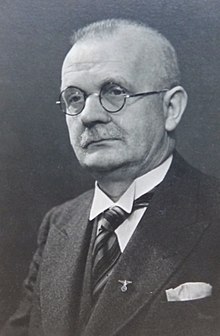Paul Stanke
Paul Stanke (born August 24, 1875 in Charlottenburg , † April 17, 1948 in Berlin ) was a German architect who was particularly concerned with the planning and construction of electrical engineering systems.
Life and education
Paul Hermann Stanke was born on August 24, 1875 in Charlottenburg and baptized there on November 7, 1875 in the Protestant Luisenkirche. His parents were the master stonemason and sculptor and later marble manufacturer Carl Hermann Stanke (1846–1907) and Bertha, née. Kietzmann. (1846–1931) Paul Stanke initially completed an apprenticeship as a bricklayer. He then studied civil engineering at the Technical College in Berlin and then architecture at the Technical University in Charlottenburg.
Professional career
After successfully completing his studies, he took up his first position at the Royal Prussian District Building Inspectorate in Langenschwalbach (now Bad Schwalbach ). He then worked as an architect for the city of Berlin, but also worked as a freelance architect. At that time he was one of the architects supervising the construction of the Berlin district and regional court, specializing in the construction of electro-technical systems. From July 1, 1901 (until 1909) worked for the State Insurance Institute Berlin. His tasks here lay in the planning and execution of the combined heat and power plants for the construction of the Beelitz sanatorium , which is now a listed building , a then new form of energy generation ( combined heat and power ). From 1909 until his retirement in 1936, he worked for the then Elektrizitätswerke Südwest AG, later BEWAG , as head of the construction department. From 1910 to 1912 he built the Wilmersdorf power station with the Ließe house and later, from 1926 to 1929, he was responsible for its expansion and modernization. Other electrotechnical structures in Berlin were the substation on Münsterstrasse in 1922 and the Prinzregentenstrasse substation from 1926 to 1929. The substation on Prinzregentenstrasse and the BEWAG administration and production building on Tempelhofer Weg are listed in the monument database of the State of Berlin. Stankes style developed in the construction forms on the classical modern , however, deviating from it, he used bricks as building material (see e.g. picture of the portal of the substation Prinzregentenstrasse)
In addition to his salaried work, he worked as a freelance expert and appraiser. Since 1904 for the district of the Potsdam Regional Court, for the district of the Kammergericht since 1925 and since 1908 for the Berlin Chamber of Crafts, as well as for the Berlin Chamber of Commerce and Industry since 1924. On April 25, 1932 he was awarded the title of Master Builder.
Stanke had been married to Johanna Schulz (August 10, 1881 to December 6, 1946) since February 8, 1902, and they had two children. He himself died on April 17, 1948 in Berlin. Both spouses are buried in the Luisenstadt cemetery.
literature
- Dietrich Oldenburg : Family ties. C, A, Starke-Verlag, Limburg 2000, ISBN 3-7980-0564-8
- Theodor Dame, Elektropolis, Michael Imhoff-Verlag, Berlin 2014 ISBN 978-3-7319-0148-8
- Günther Kühne / Manfred Hamm; Buildings of an industrial landscape, Berlin 1978
Individual evidence
- ^ Dietrich Oldenburg: Familienbande, page 257
- ^ Dietrich Oldenburg: Familienbande, pages 30 ff.
- ^ Dietrich Oldenburg: Family ties, page 31
- ↑ List of architectural and ground monuments in Brandenburg, Potsdam-Mittelmark district, D No. 09190563 and Wiki-Link Beelitz-Heilstätten
- ^ Dietrich Oldenburg: Family ties, page 32
- ↑ Thorsten Dame: Elektropolis, pages 232/33
- ↑ Thorsten Dame: Elektropolis, page 253
- ↑ Thorsten Dame: Elektropolis, page 263
- ^ Landesdenkmalamt Berlin: Monument database, object number 09011499
- ^ Landesdenkmalamt Berlin: Monument database, object number 09066705
- ↑ Google Article 1926/29 Berlin Portal BEWAG substation by Paul Stanke, www.flickriver.com/photos 543598233 N03 / 7608033500 /
- ^ Dietrich Oldenburg: Family ties, page 23
- ^ Dietrich Oldenburg: Familienbande, note 44, page 262
| personal data | |
|---|---|
| SURNAME | Stank, Paul |
| BRIEF DESCRIPTION | German architect |
| DATE OF BIRTH | August 24, 1875 |
| PLACE OF BIRTH | Charlottenburg |
| DATE OF DEATH | April 17, 1948 |
| Place of death | Berlin |
